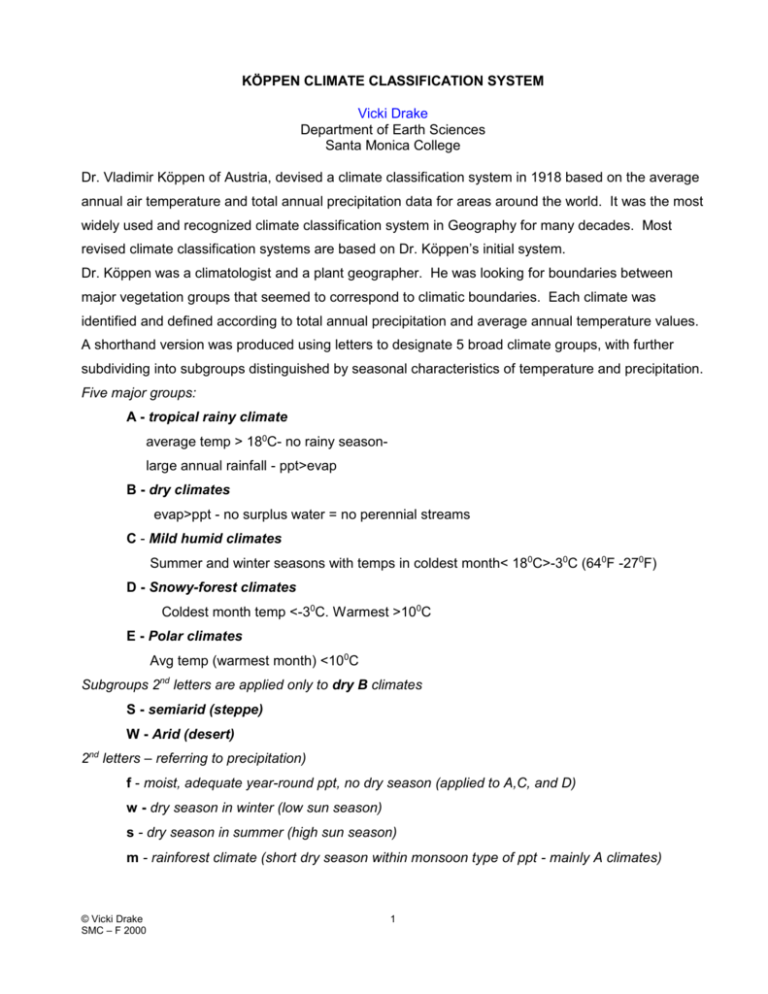KOPPEN CLIMATE CLASSIFICATION SYSTEM
advertisement

KÖPPEN CLIMATE CLASSIFICATION SYSTEM Vicki Drake Department of Earth Sciences Santa Monica College Dr. Vladimir Köppen of Austria, devised a climate classification system in 1918 based on the average annual air temperature and total annual precipitation data for areas around the world. It was the most widely used and recognized climate classification system in Geography for many decades. Most revised climate classification systems are based on Dr. Köppen’s initial system. Dr. Köppen was a climatologist and a plant geographer. He was looking for boundaries between major vegetation groups that seemed to correspond to climatic boundaries. Each climate was identified and defined according to total annual precipitation and average annual temperature values. A shorthand version was produced using letters to designate 5 broad climate groups, with further subdividing into subgroups distinguished by seasonal characteristics of temperature and precipitation. Five major groups: A - tropical rainy climate average temp > 180C- no rainy seasonlarge annual rainfall - ppt>evap B - dry climates evap>ppt - no surplus water = no perennial streams C - Mild humid climates Summer and winter seasons with temps in coldest month< 180C>-30C (640F -270F) D - Snowy-forest climates Coldest month temp <-30C. Warmest >100C E - Polar climates Avg temp (warmest month) <100C Subgroups 2nd letters are applied only to dry B climates S - semiarid (steppe) W - Arid (desert) 2nd letters – referring to precipitation) f - moist, adequate year-round ppt, no dry season (applied to A,C, and D) w - dry season in winter (low sun season) s - dry season in summer (high sun season) m - rainforest climate (short dry season within monsoon type of ppt - mainly A climates) © Vicki Drake SMC – F 2000 1 3rd letter to denote further variations in climate (temperature) a - hot summer (>220 C) C & D climates b - warm summer (<220 C) C & D climates c - cool, short summer (< 4 months with temps >100 C) C & D climates d - very cold winters (<-380 C-coldest month) C & D climates h- dry-hot (mean annual temp > 180 C) B climates only k - dry-cold (mean annual temp <180 C) - B climates only Combinations of these letter groups form distinct climates Af - Wet Equatorial - Tropical rainforest rainfall of driest month >6 cm Am - Monsoon /Trade Winds rainfall of driest month <6 cm (strong dry season) Aw, Cwa – Wet-Dry Tropical - one month with ppt <6 cm BSh - Dry Tropical - Steppe climate Dry Tropical Semiarid with grasslands BWh - Dry Tropical - Arid climate (15-250 N/S deserts) BWh, BWk, BSh, BSk - Dry Subtropical (25-330 N/S deserts) Cfa - Moist Subtropical - mild humid climate - no dry season Csa, Csb - Mediterranean - mild humid climate with dry (warm-hot) summer Cfb, Cfc – Marine West Coast – year-round ppt, greatest in winter months Dfa, Dfb, - Moist Continental - Snowy-forest climate moist winter; no dry season Dwa, Dwb - Moist Continental - Snowy-forest climate with a dry winter BWk, BSk – Dry Mid-Latitude – cP in winter, mT in summer Dfc, Dfd, Dwc, Dwd – Boreal Forests – greatest temp. range of all climates ET - Tundra climate - warmest month average temp <00 C > 100 C EF - Perpetual frost climate - mean monthly temps <00 C © Vicki Drake SMC – F 2000 2









